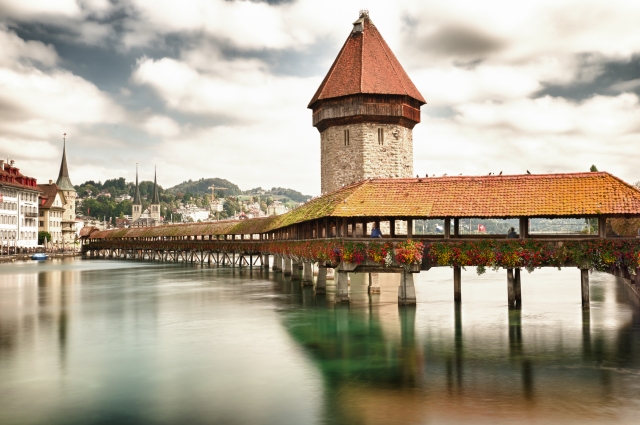KAPELLBRUCKE, literally CHAPEL BRIDGE is a covered wooden footbridge spanning diagonally across the River Reuss in the city of Lucerne in Central Switzerland.
Named after the nearby Saint Peter’s Chapel, the bridge is unique, since it contains a number of interior paintings, dating back to the 17th century, although many of them were destroyed along with most of the centuries-old-bridge in a 1993 fire. Subsequently restored, the KEPELLBRUCKE is the oldest wooden covered bridge in Europe, as well as the world’s oldest surviving “truss” bridge. It serves as the city’s symbol and as one of Switzerland’s main tourist attraction.
As part of the bridge complex, the KAPELLBRUCKE includes the “octagonal” 140ft tall WASSERTURM, which literally translates to WATER TOWER. However, the tower is not a water tower, in the usual sense, but the name comes from the fact that the tower is standing in the water. The tower pre-dated the bridge by about 30 years. Throughout the centuries, the tower was used as a ‘prison’, ‘torture chamber’ and, later, a ‘municipal archive’. Today, the tower is closed to the public, although it houses a local artillery association as well as a tourist gift shop.
The bridge, itself, was originally built in 1333 as part of Lucerne’s fortification. It linked the old town on the right bank of the River Reuss to the new town on the left bank, securing the city from attack from the south (i.e. from the lake). The bridge, initially, had a length of over 660ft, although due to numerous shortenings throughout the years and riverbank replenishments, the bridge now totals only 560ft in length. It is the oldest surviving “truss” bridge in the world, consisting of “strutted” and “triangulated” trusses of moderate span, supported on piled “trestles” ; as such, it is probably an evolution of the “strutted” bridge.
The KAPELLBRUCKE almost burned down on August 18, 1993, destroying two-thirds of its interior paintings and killing one person. Shortly thereafter, the KAPELLBRUCKE was reconstructed and again opened to the public on August 14, 1994 at a cost of US$ 2.1million.
Lucerne is unique in the fact that its three wooden pedestrian bridges, the 14th century HOFBRUCKE (now destroyed), the KAPELLBRUCKE and the 16th century SPREUERBRUCKE, all featured painted interior triangular frames. This feature is not replicated in any of Europe’s other wooden footbridges. The paintings, dating back to the 17th century, by local Catholic painter Hans Heinrich Wagmann, depict events from Lucerne’s history. Out of the original 158 paintings, a total of 147 existed before the 1993 fire. After the fire, the remains of 47 paintings were collected, although only 30 were ultimately fully restored.
The wooden boards upon which the paintings were painted were from 59 — 71 inches wide and 33 — 37 inches wide. Most of the panels were made from spruce wood boards, while only a few were made from linden wood and maple. The paintings were created during the time of the Counter-Reformation, featuring scenes promoting the Catholic Church. The paintings, themselves, were sponsored by the city’s counsel members, who, upon sponsoring a panel, were allowed to attribute their personal “coat of arms” on it. An explanation of each painting was printed below each scene. The paintings ran all along the bridge, dating from the life and death of Lucerne’s Patron Saint ——— Saint Lager to the legends of the city’s other Patron Saint ———- Saint Maurice.






Reblogged this on oshriradhekrishnabole.